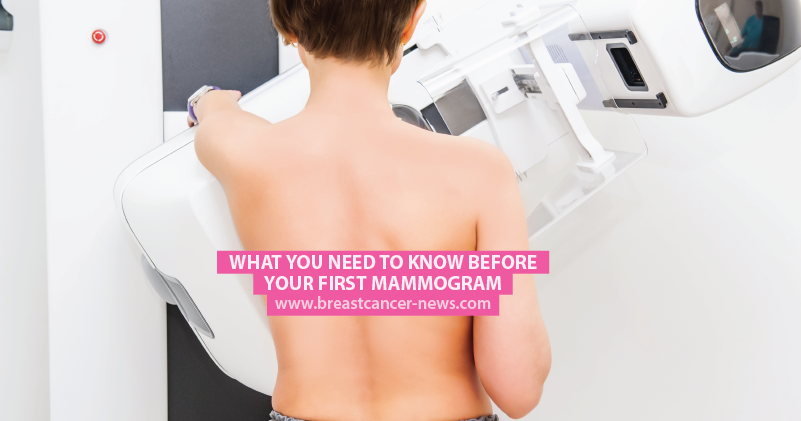No one wants her breast smashed in a vice, but it’s not that bad.
Yes, everyone’s busy. Do it anyway.
Screening saves lives.
If you’ve never had a mammogram, here’s what to expect:
The prep
On the day of your exam, skip the deodorant because it can interfere with the results of your images. Yes, you might be nervous and sweaty. Maybe you’ll even smell like the locker of your favorite football team after an overtime game in the tropics. So what? It’s better than cancer. The exam doesn’t take very long, and when it’s over, you can have all the girly soap and antiperspirant you want.
You’ll be asked to disrobe from the waist up, so be sure to wear a skirt or pants instead of a dress to your appointment. That way, you’ll only be naked on the top part of your body.
The look
Your clinic will give you a fabulous gown to wear while your own clothes languish on a hook. Spoiler alert: these gown are not like the sequinned, off-the-shoulder numbers you see on Oscar night. Usually, they’re pale blue or some other unflattering color, made from a horrible piece of fabric, and they tie loosely in the front so that if you move a muscle, you’ll expose yourself to everybody in sight. No worries. The people around you are all either there for the same reason, or they’re working to make sure you stay cancer-free.
MORE: How to get a good night’s sleep after a cancer diagnosis
The wait
While you wait for your turn, you’ll get to catch up on all the magazines you wanted to read but haven’t had time for. You may even find a recipe to tear out and toss in a drawer when you get home. It will give you something to throw away next year when you do spring cleaning.
Eventually, they’ll call your name and you’ll go into a room with a technician and a mammogram machine. Relax. They’re just going to take a few images.
The test
Mammogram machines use a low-dose, non-invasive X-ray to detect irregularities in breast tissue. If you do it every year, cancers can be detected early — up to two years before you can feel a lump during a self exam. The American College of Radiology recommends that all women, starting at the age of 40, get an exam every year. Early detection is important, because that’s when cancer is easiest to treat.
The technician will position your breast on a panel, and another panel will close down on top of it, flattening it out. Ouch! Not a big ouch, just enough to justify dessert or some other treat when the appointment is over. Your technician might want to get several views, so this process could be repeated a few times.
The mammogram machine is amazing technology, and while it’s squeezing your breasts and manipulating your body, you might find yourself marveling at the genius of it all. Or you might just count down the minutes till your appointment is over. It’s your choice.
The final step
After you finish, there’s just one thing left to do: ask your mom, your sister, your aunt, or your friend if she’s had her mammogram and give her a gentle push if her answer is no. After all, we girls need to look after each other.
MORE: Three tea recipes for breast cancer patients
Breast Cancer News is strictly a news and information website about the disease. It does not provide medical advice, diagnosis or treatment. This content is not intended to be a substitute for professional medical advice, diagnosis, or treatment. Always seek the advice of your physician or another qualified health provider with any questions you may have regarding a medical condition. Never disregard professional medical advice or delay in seeking it because of something you have read on this website.


Great article! You might want to follow up with this article and ask – What to do after you have a mammogram? It is critically important that women read their ENTIRE mammography reporting results – in 31 states legislators passed laws to protect women with dense breast tissue from delayed and advanced breast cancer – as dense breast tissue hides cancer on 2d and 3d mammograms – Read your report and look for information about you breast tissue composition – if there is nothing about this in your report, call your breast center and ask if you have dense tissue – if you do, talk to your docs about added screening beyond the mammogram. For more information and a patient friendly guide to screening women with dense breasts http://www.areyoudenseadvocacy.org
A few years ago, if you told me I’d be discussing my breasts on the internet, I never would have believed it. But the fact is that I have dense breast tissue, and there’s no such thing as TMI when it comes to preventing cancer. Thanks for a great suggestion – I’ll follow up.
Thanks Nancy – yes me too – average risk woman and NEVER missed my mammogram – stage 3C – the culprit was dense tissue & never knew I had it nor should be concerned even though it was in peer reviewed research for decades!
Nancy Cappello – as a follow up, please visit this link which was inspired by your comment. http://breastcancer-news.com/2018/02/15/dense-breast-tissue-101-information-every-woman-needs-to-know/
Hi Nancy,
I am pleased you added the important masking and risk of breast cancer – as it is very important that when woman have a mammogram she discusses her breast tissue with their docs.
31 states have density reporting laws – for more information go to http://www.AreYouDenseAdvocacy.org